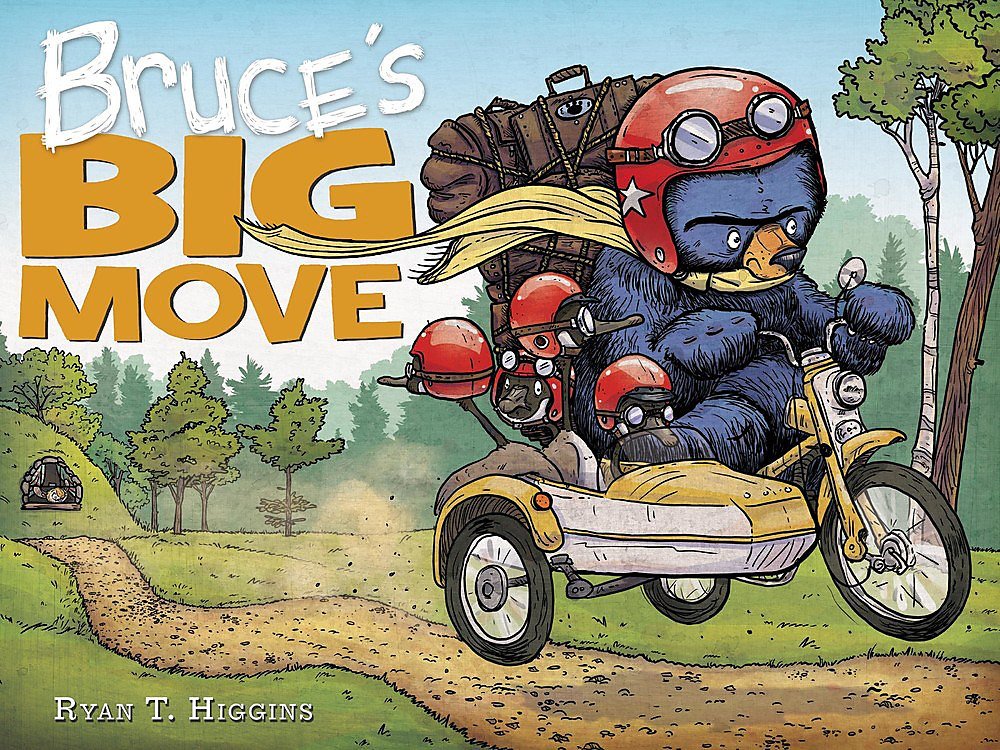This month's Book Nook topic is...
Explaining with Bruce’s Big Move

Understanding the reasons that things happen is an important part of story comprehension. The child may have a sense of what is happening, but they may need support to figure out why an event occurred. By asking the child “why” questions and commenting with explanations of your own, you encourage the child to go beyond the words in the book and draw on their knowledge and reasoning skills.
Let's get started!
The Book:
Bruce’s Big Move by Ryan T. Higgins
Why we chose this book
This is a story of a grumpy bear named Bruce who shares his home with four geese, and three rowdy mice! Bruce is fed up with the mess and the noise, so he sets off to find a new home, but nothing goes quite according to plan. Bruce goes on a reluctant adventure that keeps readers engaged and giggling. This story presents many opportunities to talk about why things happen and offer possible explanations.
Building understanding in the first reading
When you read this story for the first time, it’s best to keep the story moving and have very short conversations that help the child remember the main characters, their actions, and what the main problem is. For example, you could make comments like:
- “This story is about Bruce. He is the main character.”
- “There is a problem. Bruce is not happy because there is so much mess and noise at home.”
- “Bruce tried to solve his problem by moving to a new house.”
Incorporating explanations into later readings
Once the child has grasped the basic story, they will be able to think about it in different ways and have longer, more in-depth conversations. When we encourage children to offer their ideas and explanations, we help to build their understanding of how one event leads to another (i.e. cause and effect). This will help prepare them for the demands of school, where they are often asked “why” questions.
You can encourage your child to think about why things happen by using these two strategies:
- Making “thinking-out-loud” comments
- Asking questions that encourage explanations
Making thinking-out-loud comments
These comments show the child how you are thinking about the problem in the story and that you are trying to figure out information that is not explicitly stated. Although comments don’t require a response from the child, you can make a comment and then pause to give them time to think about what you have said. The child may take the opportunity to respond.
For example, you could say:
- “I wonder why Bruce liked living with the geese but not the mice.”
- “I think Bruce wanted to move because the house was crowded and loud.”
- “Let’s think about why Bruce didn’t like playing the game of frying-pan ball.”
- “Maybe the geese miss the mice and that’s why they aren’t happy at the new house.”
- “I’m thinking that Bruce doesn’t like having so many friendly neighbors because they might be loud.”
Using these types of comments model a way for your child to discuss their own thoughts and ideas about why things happen. Another way to support these higher-level thinking skills is to ask questions.
Asking questions that encourage explanations
Asking questions about why things are happening encourages your child to use their knowledge and reasoning skills. For example:
- “Why do you think Bruce is having a hard time finding a new home?”
- “What’s the reason Bruce doesn’t like having so many friendly neighbors?”
- “Why do you think the geese were happier when the mice arrived?”
- “At the end of the story, the geese and the mice were in Bruce’s bed again. Why did Bruce let them stay?”
If the child has difficulty answering questions like these, you can provide the answer and then continue reading the book. For example, if you ask, “Why did Bruce want to move?”, then wait a few moments but your child doesn’t respond, you could say “maybe he wanted to move because he thought it would be quieter at a different house”.
The more times you read the story, the more often you will be able to make “thinking-out-loud” comments and ask questions that deepen your child’s understanding. These conversations also develop the language skills needed for higher level thinking, as well as laying a foundation for successful independent reading.
Happy Reading!
More Resources
The strategies in this Book Nook post are drawn from Hanen’s practical, research-based guidebooks for building emergent literacy. Explore the links below to learn more about how these guidebooks can support you.
For Parents I'm Ready! guidebook
I'm Ready! guidebook
For Educators ABC and Beyond guidebook
ABC and Beyond guidebook
